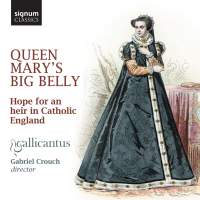Texte paru dans: / Appeared in: |
|
|
Outil de traduction ~ (Très approximatif) |
|
|
Reviewer: James
A. Altena
The somewhat unusual topic for
this selection of sacred motets and lute songs is the first of Queen Mary of
England’s two false pregnancies, this one occurring from November 1554
through July 1555. (The second one, in 1558, was probably related to the
uterine cancer that took her life at the end of that year.) The supposed
pregnancy was a matter of the greatest import for both England and
international affairs. When Mary came to the throne in 1553, England had
passed through a quarter-century of extreme religious tumult. Following
unsuccessful efforts to obtain a papal annulment of his first marriage to
the Spanish princess Catherine of Aragon, Henry VIII through Parliament had
imposed an idiosyncrati-cally conservative version of the Reformation in
England. It recognized his divorce of Catherine and marriage to Anne Boleyn,
rejected papal authority in the realm, and confiscated a good deal of church
property, but otherwise still adhered to traditional Catholic doctrine.
Following his death in 1547, the Protestant guardians of the boy king Edward
VI (Henry’s son by his third wife, Jane Seymour, who died in childbirth) had
advanced a thoroughly Protestant agenda through promulgation of the newly
created Book of Common Prayer, a text that ranks alongside the 1611
Authorized (King James) translation of the Bible and the works of
Shakespeare as one of the three seminal formative influences upon the modern
English language.
However, Edward’s premature
death at age 15 brought his older sister Mary, daughter of the disowned
Catherine and a devout Catholic, to the throne. Although she initially
announced a policy of religious tolerance, she quickly moved to resubmit the
church in England to papal authority and undertook a bloody campaign of
religious persecution that sent 283 Protestant martyrs to the stake within
five years. In July 1554, in another move both to secure England to papal
obedience again and to stabilize the royal succession by producing an heir,
Mary also married Prince Philip of Spain (subsequently Philip II of Spanish
Armada notoriety). While she was deeply enamored of her husband—a factor
that may have contributed to the false pregnancy—he regarded her far more
cooly in terms of a political alliance. Since Mary’s health was known to be
frail, Philip repeatedly made efforts to negotiate an agreement to preserve
his status as regent of England such that, if Mary died in pregnancy, he
would then marry her half-sister and immediate successor Elisabeth, Henry’s
daughter by the disgraced and executed Anne Boleyn. Hence the prospective
birth of an heir to the throne by Mary was fraught with extraordinary
political significance for cementing England’s renewed religious allegiance
to Rome and political alliance to Spain. False rumors of the birth of a son
on April 30, 1555, triggered premature celebrations in England among
Catholics and a spreading of rumors to the Continent. Ultimately, Mary would
die without producing an heir, Elizabeth would succeed her instead, and
England would be secured for Protestantism thereafter.
Of the works featured in this
release, one—the Sarum Litany of Thomas Tallis—is directly connected to
Mary’s pregnancy, as surviving manuscripts have handwritten interpolations
of intercessions for Mary and Philip. Unfortunately only two partbooks, for
the medius and bassus, have survived; however, the tenor part is based on
the traditional plainsong tone for the litany, and this allows for a
plausible reconstruction of the two contratenor parts. Some of the other
pieces—e.g., the Lassus motet, written to honor the newly appointed Catholic
Archbishop of Canterbury, Reginald Pole—have associations with surrounding
events or Mary’s court more generally. The inclusion of a Latin motet by
Christopher Tye raises an eyebrow, since he was an ardent Protestant who was
Edward VI’s music teacher. Back in 33:6 I gave a rave review to the debut recording of Gallicantus, a disc of motets by Robert White, and J. F. Weber accorded a successor disc of works by Byrd and Monte a similarly enthusiastic greeting. While this new disc also deserves a welcome for its repertoire, my enthusiasm in this case is a bit muted due to some occasionally rough singing and patches of slightly off intonation—not many or serious, but just enough to be noticed. One hopes that next time out, more time and resources will be available for this ensemble to lend its efforts that last degree of polish which characterized its previous outings. That said, this disc still definitely warrants a recommendation. Full texts and translations are included, along with detailed booklet notes, illustrations, artist bios, and a table showing which members of Gallicantus sing in which pieces, all showing thoughtful care. | |
|
Support us financially by purchasing this disc from eiher one of these suppliers. Un achat via l'un ou l'autre des fournisseurs proposés contribue à défrayer les coûts d'exploitation de ce site. |
|
|
|
|
|
Cliquez l'un ou l'autre
bouton pour découvrir bien d'autres critiques de CD |
|




